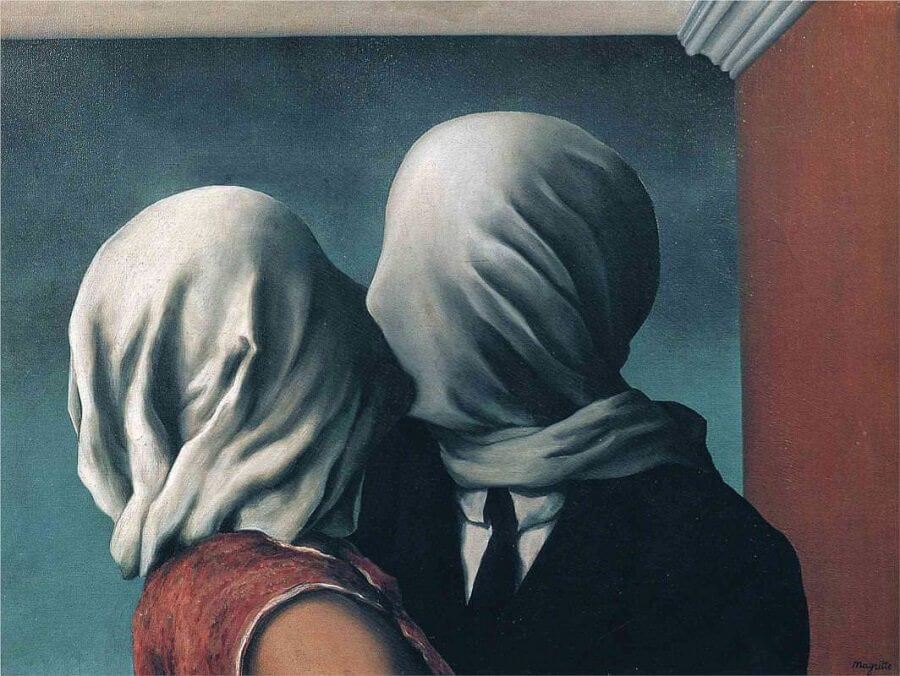You’ve likely encountered René Magritte’s captivating and unsettling painting, “The Lovers II.” But have you paused to truly contemplate its layers of meaning? Beyond the striking image of veiled figures locked in a passionate embrace, lies a surrealist exploration of intimacy, identity, and the inherent mysteries within human connection. Join us as we delve into this iconic artwork and unravel some of its potential interpretations. Don’t forget to share your own thoughts in the comments below!
A Closer Look: Unveiling the Details
Painted in Paris in 1928, “The Lovers II” (French: Les Amants) is the first in a series of four variations on this intriguing theme. Currently residing in the Museum of Modern Art (MoMA) in New York City as part of the Richard S. Zeisler Collection, the painting immediately draws the viewer in with its central focus: two individuals engaged in a fervent kiss, their faces completely obscured by white cloth.

Beyond the veiled kiss, other details contribute to the painting’s enigmatic atmosphere:
- The Setting: In the upper right corner, a suggestion of a house wall hints at an intimate, perhaps domestic setting. The figures stand before what could be interpreted as a dark sky or a solid-colored wall, topped by a visible ceiling, further emphasizing an enclosed space.
- The Figures: We can discern subtle clues about the individuals. One figure appears masculine, with short hair and wearing a suit, suggesting formality. The other figure, presumably female, has longer hair, the exact length of which remains ambiguous. She seems to be wearing a dress, though its formality is unclear.
- The Central Barrier: The most striking element is undoubtedly the white cloth enveloping their heads as they kiss. This barrier transforms an act typically associated with closeness and vulnerability into one of separation and concealed identities.
Unpacking the Meaning: Layers of Interpretation
The beauty of surrealist art lies in its open-endedness, inviting individual interpretation and reflection. From our perspective, “The Lovers II” can be seen as a potent metaphor for various aspects of love and relationships:
- The Uncertainty of New Love: When falling in love, we often navigate the unknown. We are drawn to another person without complete knowledge of their past, their true intentions, or the future that lies ahead. The veiled faces could represent this initial blindness, the willingness to embrace connection based on feeling and limited understanding.
- The Fragility of Connection: Conversely, the painting could also reflect on a love that is fading or has already perished. The intimacy of the setting and the formality of the attire might highlight the efforts made towards a serious relationship, yet the covered faces suggest a fundamental disconnect, a love destined to fail despite outward appearances. Were the kisses already doomed?
- The Illusion of Knowing: Perhaps the veils symbolize the inherent unknowability of another person, even in the most intimate of relationships. We may believe we truly know our partners, but there will always be hidden aspects, unspoken thoughts, and veiled emotions.
- Frustration and Unfulfilled Desire: The barrier of the cloth undeniably introduces an element of frustration. The passionate kiss is thwarted, a longing for true intimacy hindered by an unseen obstacle. This could represent any number of barriers that can exist within a relationship, preventing complete and uninhibited connection.
Art as a Therapy: Reflecting on Love and Connection
One of art’s most profound gifts is its ability to illuminate our own lives and the complexities of human experience. “The Lovers II” serves as a powerful visual prompt for introspection on the nature of love.
The painting subtly whispers a crucial message: “Love is blind.” Yet, it also acts as a cautionary note, urging us to approach love with a degree of awareness. While the initial stages of romance may involve a certain degree of “falling,” true love requires more than just blind faith. It necessitates acceptance – not just of the other person’s strengths, but also their flaws and the inherent fragility of any relationship.
Love is not a guaranteed state; it is a dynamic journey that demands effort, understanding, and a willingness to navigate change together. Entering a relationship to escape personal insecurities or for superficial reasons like status or convenience can lead to significant emotional and other costs.
Magritte’s “The Lovers II,” with its unsettling beauty, invites us to consider the visible and invisible forces that shape our connections, reminding us that true intimacy requires more than just physical closeness – it demands a willingness to see and be seen, beyond any concealing veils.
What are your interpretations of “The Lovers II”? Share your thoughts in the comments below – we’d love to hear your perspective!



